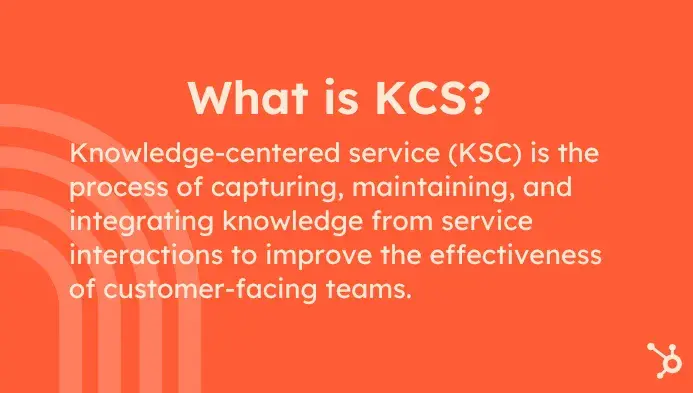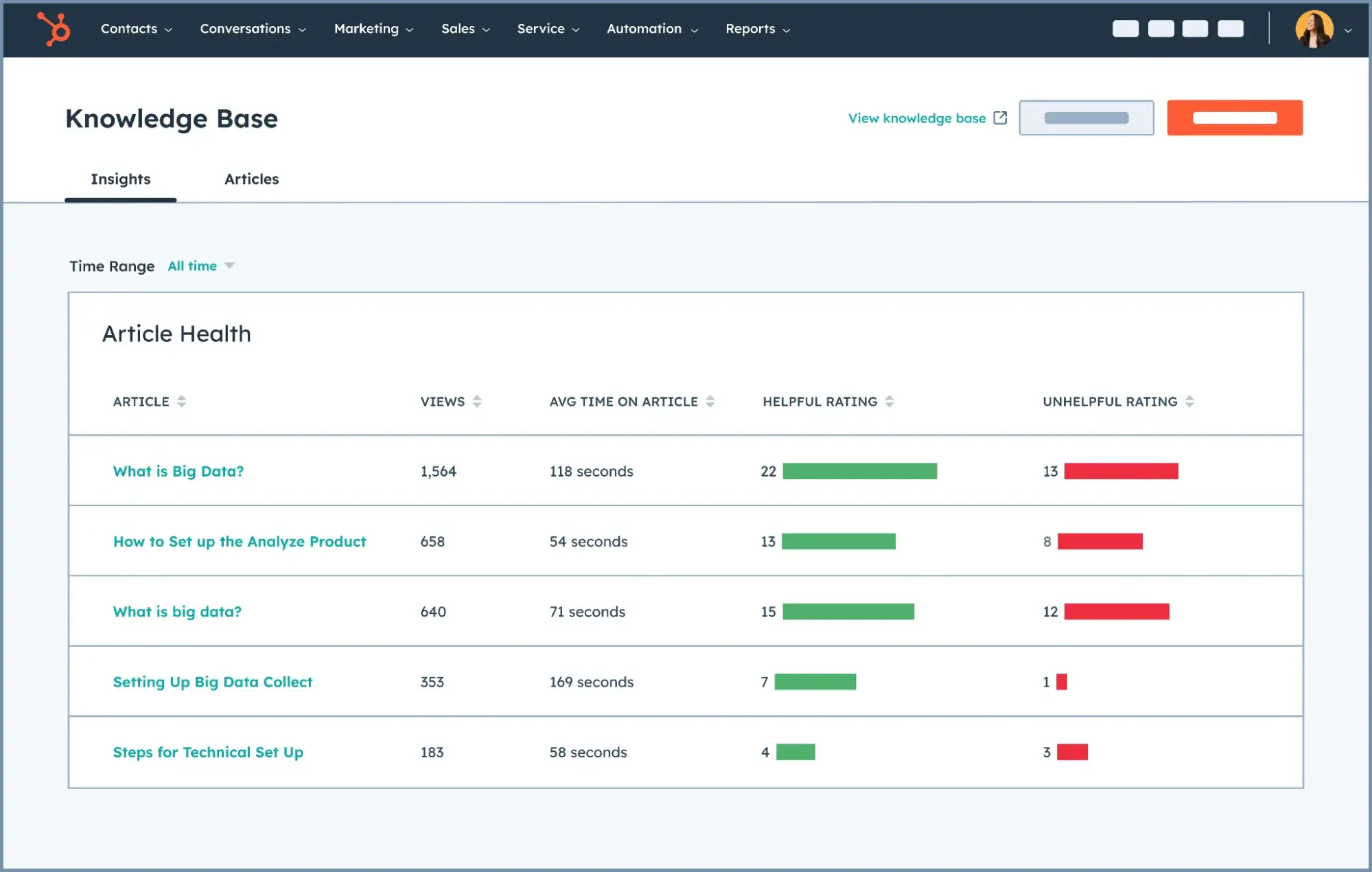In this post, I’ll explore knowledge-centered support, its benefits and challenges, and how to implement it within your organization.
In this article:
- Knowledge-Centered Service vs. Knowledge-Centered Support
- What is knowledge-centered service (KCS)?
- How Knowledge-Centered Service Works
- Benefits of KCS
- Challenges of KCS
- KCS in the AI Era
- KCS Training and Resources
Knowledge-Centered Service vs. Knowledge-Centered Support
Before we get down to business, I’ve got to define some terms. If you’re familiar with KCS or have been researching it, you may have noticed that the terms knowledge-centered support and knowledge-centered service are often used interchangeably.
I used knowledge-centered support in the intro above because that’s how I first encountered the methodology as a support rep at HubSpot. And until recently, that was the most common term. KCS originated in the support team context, after all.
As more organizations began applying KCS principles across other service arms, such as customer success, ITSM, and even product, the term evolved into “knowledge-centered service” to reflect its broader scope.
For the remainder of this article, I will refer to it as knowledge-centered service, or simply KCS.
Now that I've got that out of the way, let’s talk about what KCS is.
What is knowledge-centered service (KCS)?
Knowledge-centered service (KSC) is the process of capturing, maintaining, and integrating knowledge from service interactions to improve the effectiveness of customer-facing teams. In KCS, knowledge isn’t just the responsibility of a few subject-matter experts. It is owned by everyone, especially service team members who work directly with customers.
So what does that look like in practice?

Let’s say I solve a customer issue and discover a new use case or workaround. Under KCS, I’d capture that knowledge and contribute it to a shared knowledge base so the next rep (and the team as a whole) can benefit from it.
Here’s another way I’d sum it up:
- Knowledge-centered service reframes the responsibilities of customer-facing teams. Providing real-time support remains the top priority, but so does creating and maintaining documentation alongside it.
- KCS treats the knowledge and skills of service teams as valuable business assets. It focuses on keeping that knowledge up to date, improving it over time, and using it to improve customer support and help teams work better.
How Knowledge-Centered Service Works
So, how does KCS work in practice? It’s a straightforward process that involves capturing knowledge during a service interaction, structuring it so it's easy to find, and then reusing and improving it at the organizational level.
The original KCS framework breaks this process into two “loops” (Solve and Evolve), but I think it’s a bit too academic and jargon-heavy for my taste. You can learn more about the KCS double loop process here, but I’ve distilled it into five easy steps for this article.
1. Capture
As a support rep, when I encounter a new issue, learn a workaround, or discover a customer insight, I don’t just solve the case and move on. I jot down the knowledge I’ve uncovered, intending to contribute it to our knowledge base.
Pro tip: Don’t stress about writing a perfect knowledge base article at this stage. Just write down all the key details while they’re fresh and clean them up later.
2. Structure
Here’s where I’ll take my raw case notes and polish them into usable, searchable knowledge content. Structuring the knowledge could be my responsibility as a rep, or it could fall to a dedicated editor. Either way, the goal is to create a knowledge article your team can find and use later. For discoverability, use search tags and headings containing relevant keywords.
Pro tip: Use a standardized template for knowledge articles so every team member can confidently contribute. Looking for a place to start? Here are five free self-service customer support templates your team can start using today.
3. Reuse
The whole point of KCS is creating a knowledge repository that team members can actually use. So, before writing a new article, it’s my responsibility to search the knowledge base to see if someone else has already documented a solution to the problem I’m facing. If I discover an article that is slightly off or outdated, I’ll make changes on the spot.
Pro tip: Encourage service reps to include links to relevant knowledge base articles in case notes and follow-ups. It provides helpful insights to customers and team members and maintains visibility of applicable knowledge content.
4. Improve
KCS is a living, breathing process. At some point, the pace of new article creation will slow down, especially once you’ve documented the most common issues.
However, that doesn’t mean you’re off the hook. As a rep, every time I use a knowledge article, it’s my responsibility to evaluate it for accuracy, relevance, and clarity. If an article needs updates, I’ll edit or flag it for review.
Pro tip: Set up a quarterly review process to audit and refresh your most-used articles.
5. Reward
The success of your KCS system depends on consistent buy-in. That means encouraging reps and service team members to treat knowledge documentation as a core job responsibility.
One of the best ways to do that is by giving team members dedicated time to work on articles and celebrating contributions publicly. When reps see that their KCS work is making a real impact, they’re far more likely to take ownership.
Pro tip: Send a monthly “Editor’s Picks” email highlighting top-performing knowledge articles. Be sure to shout out the authors; a little recognition goes a long way.

In summary: Knowledge-centered service is a methodology that helps organizations create a centralized knowledge base, supported by a loop of continuous capture, reuse, structuring, and improvement of knowledge.
If you’re looking for the perfect platform for starting your KCS journey, check out HubSpot’s Knowledge Base Software. It can help you:
- Quickly create knowledge articles.
- Improve your content and fill gaps with powerful insights and analytics.
- Organize knowledge base articles by topic.
Benefits of KCS
Knowledge-centered support has the power to transform your service team into a bastion of efficiency, continuous improvement, and customer satisfaction. Here are the key benefits of implementing KCS.
Improved Resolution Times
When KCS works as intended, support reps can easily access the knowledge documentation they need to resolve customer issues quickly. In my experience as a support rep, proper knowledge documentation is the difference between confidently solving problems and putting customers on hold while you scramble to troubleshoot or ping a colleague for help.
According to the Consortium for Service Innovation, KCS can improve resolution times by 25-50% within the first 3-9 months of implementation.
Faster Onboarding and Smarter Reps
When I joined the HubSpot Support team, I relied heavily on internal and external knowledge documentation to supplement my training. I can confidently say that I wouldn't have reached proficiency nearly as fast without knowledge articles and the KCS framework that supported them.
The benefits don’t stop at training, though. I relied on knowledge documentation daily to troubleshoot cases, and knowing it was consistently maintained gave me peace of mind when helping customers under pressure.
According to Atlassian, KCS can reduce the time it takes for new reps to reach proficiency by 70%, making onboarding more efficient and setting reps up for long-term success.
Improved Self-Service and Customer Satisfaction
As a customer myself, I’d rather not pick up the phone if I don’t have to. I’d much rather find the answer to my problem online and move on. KCS supports this process by documenting the knowledge from every solved issue to create a continuously improving knowledge base or help center.
When I can find the answers I need via knowledge documentation, I feel empowered and much more satisfied having saved myself the time required to call in. The result? Reduced friction and improved customer satisfaction.
Don’t just take it from me, though. 88% of customers expect access to self-service resources, and KCS helps you meet and exceed those expectations.
Challenges of KCS
Implementing KCS can improve your service organization, but it’s not without its challenges.
Implementing a Cultural Shift
Proper KCS requires complete buy-in from your service or support teams to treat documentation as a core part of the job. That can be a difficult cultural shift, especially if reps aren’t used to prioritizing and relying on knowledge documentation in their daily work.
Getting complete buy-in requires a heavy lift from leadership to reinforce the idea that knowledge documentation is a core part of delivering excellent service.
It’s also important to give team members extra time to incorporate knowledge capture into their workflows. Tacking on additional responsibilities to your already busy team members isn’t likely to be a popular initiative if they are not compensated accordingly or afforded extra time.
Quality Control
The “too many cooks in the kitchen” effect is a risk when every team member contributes to your knowledge base simultaneously. Unchecked, knowledge articles could vary widely in tone, formatting, and depth, making for a chaotic and unhelpful knowledge base experience.
However, strong review processes and clear article templates can keep your knowledge documentation accurate and consistent. If your team is large, consider a dedicated editorial role for distilling raw knowledge into consistent, polished documentation.
Ongoing Maintenance
Your knowledge documentation must keep pace with product updates, new features, and policy changes. Without regular maintenance, your knowledge base can quickly become outdated, eroding trust among your team and customers.
KCS is only effective when your knowledge is accurate and relevant. So, you’ll need to build in time for article reviews and updates alongside the knowledge capture process.
KCS in the AI Era

AI isn’t here to replace customer service agents and make knowledge-centered service obsolete. Quite the opposite, in my opinion.
AI has the potential to supercharge KCS efforts and help reps create efficient, personalized customer experiences. In fact, one study found that AI-enabled customer service teams resolve customer issues 44% faster and experience a 35% increase in the quality and consistency of support.
In the KCS world, AI can streamline knowledge capture and enable teams to create high-functioning help centers in record time.
If I had access to these tools back when I was working at HubSpot Support, I would have saved hours each week capturing and formatting documentation. Instead of manually turning case notes into polished articles, you can submit your knowledge to AI with formatting guidelines and instructions and receive a first draft instantly. Then, all you have to do is focus on reviewing for clarity and accuracy instead of taking the time to write a whole post from scratch.
AI tools can also analyze case history and chat logs at scale to identify recurring issues and knowledge gaps that previously would have gone unnoticed. It can even monitor your knowledge base and automatically flag outdated articles for review.
Bottom line, I’m bullish on the role of AI in knowledge-centered service and customer support in general. The key is not to replace the human element with AI but to use it to optimize the process.
Excellent documentation will always require human context and judgment, but with AI handling the busywork, reps can focus on what matters: solving for the customer.
Pro tip: If you're looking for knowledge-base software to run your KCS system, check out Service Hub’s knowledge base software.
KCS Training and Resources
Certification and Training
If you’re looking for formal training, the KCS v6 Fundamentals certification is a training certification targeted explicitly towards teams that use KCS to solve customer problems.
This paid, entry-level certification helps organizations develop a basic understanding of KCS. If you‘re interested, the KCS Academy includes a reading list that covers the course’s principles, core concepts, and practices.
Resources From the Consortium for Service Innovation
If you‘re interested in adopting KCS for your business, check out the resources I’ve gathered below. The Consortium for Service Innovation offers many resources to help you learn more about KCS. Here are some to bookmark.
1. KCS Principles and Core Concepts
This document offers a foundation for the KCS methodology. It also covers the four principles and ten core concepts crucial to KCS.
2. KCS v6 Practices Guide
This guide describes the basic practices and techniques incorporated into the KCS methodology and provides a more in-depth look into the Solve and Evolve Loops.
3. KCS v6 Adoption Guide
This guide covers a step-by-step process for adopting KCS into your organization. It offers tips on successfully incorporating the methodology, including getting your team to embrace procedural changes.
4. Frequently Asked Questions about KSC v6
These FAQs cover topics like how KCS was developed, who owns the methodology, and how to use and share KCS data legally. This will help your team avoid any legal trouble when using KCS.
5. Glossary of KCS Terms
Some KCS terminologies are confusing. This appendix provides essential definitions you'll need to know when educating yourself or others on KCS.
6. Metrics Matrix
This appendix lists the KCS metrics that your organization can use to analyze your performance. You'll need this to measure how effective your new support system is.
7. Article Quality Quick Reference Guide
This great tool helps your team structure your knowledge base articles. This guide covers everything from layout to style tips that you can use to optimize customer experience.
8. Stakeholder Engagement Matrix
This matrix offers techniques for building and maintaining stakeholder engagement through every phase of your adoption process. You can use this resource to explain to stakeholders why KCS is a good move for your company.
9. Measurement Matters
This document provides an in-depth look at the short and long-term benefits that KCS can offer. It is essential for convincing employees and other stakeholders that KCS will benefit the business.
10. New vs. Known Methodology
This paper introduces the New vs. Known study that assesses the health and effectiveness of an organization's KCS practices. You can compare your business to the ones in this study to see if you can improve any function in your KCS system.
Case Studies
The following case studies discuss the experiences of different organizations that have adopted the KCS methodology.
11. Quest
Quest set a goal of publishing 90% of its solutions to its knowledge base before the support case is closed. Now, 70% of its support cases are solved using a knowledge base article.
12. HP Enterprise
HP used KCS to build a customer-centric knowledge base. Since its creation, HP has observed a 400% increase in customer self-service solutions. That means that more customers at HP are finding their solutions without reaching out to a service rep.
13. Omgeo
Omgeo focused on embracing the activities in the “Evolve Loop.” They analyzed groups of articles to see if there were any patterns in usage, traffic, or navigation. From its research, Omgeo highlighted more opportunities to improve the customer experience.
14. MathWorks
Mathworks used KCS to create a knowledge base to centralize customer information. By adding this resource, customers began engaging with the company more than they had. Mathworks saw a 50% boost in customer comments after the installation of its knowledge base. This gives the company more chances to interact with users, including opportunities to upsell and cross-sell.
Other Learning Resources
There are also great KCS resources that were created outside the KCS Academy and the Consortium for Service Innovation. We listed a few below.
15. What is Knowledge Centered Service? KCS Explained
This blog post covers the definition, history, loops, benefits, and uses of KCS. This is an excellent post for someone who wants to gain all the information in the resources above, but in a more concise format.
16. What is KCS and Why Does it Matter?
This blog post briefly describes KCS and how it can be evolved and used in the future. It is a good read for employees looking for a quick explanation of KCS.
17. Do you know about Knowledge-Centered Service?
This LinkedIn article covers KCS's goals, key concepts, and additional management resources. It is a great way to understand its basic fundamentals.
18. IT Jargon Explained: Knowledge Management
Find out how the ITIL Knowledge Management process is used by organizations to collect organizational knowledge, improve accessibility, and eliminate redundancies.
Editor's note: This post was originally published in December 2021 and has been updated for comprehensiveness.
Knowledge Base
.png?width=112&height=112&name=Image%20Hackathon%20%E2%80%93%20Horizontal%20(14).png)

.png)









![How I Write Effective Knowledge Base Articles [+Templates]](https://53.fs1.hubspotusercontent-na1.net/hubfs/53/knowledge-base-articles-1-20250408-7398950.webp)